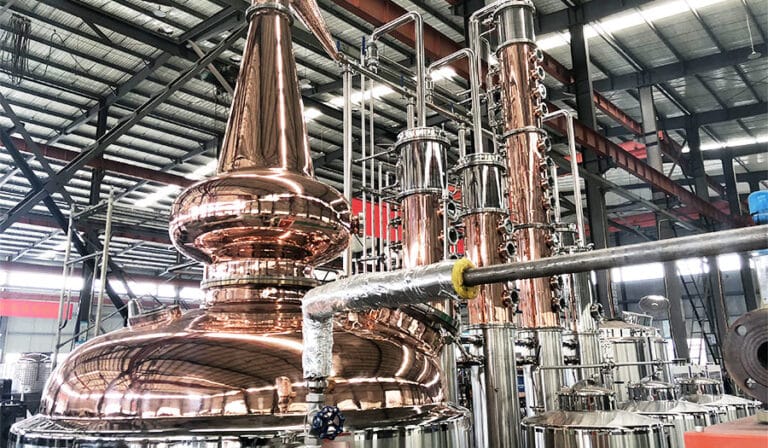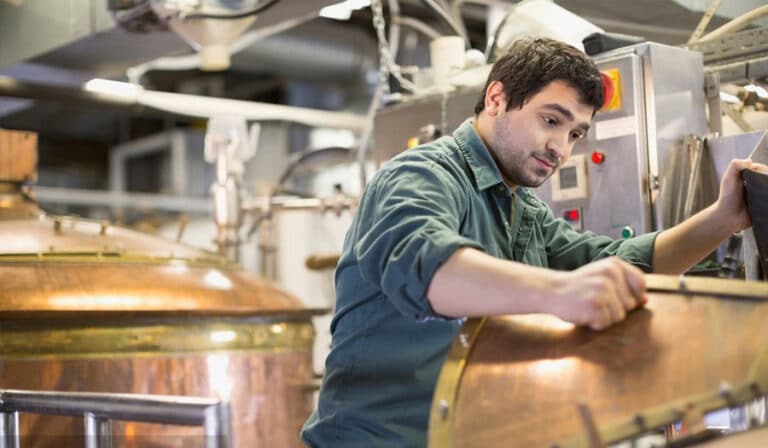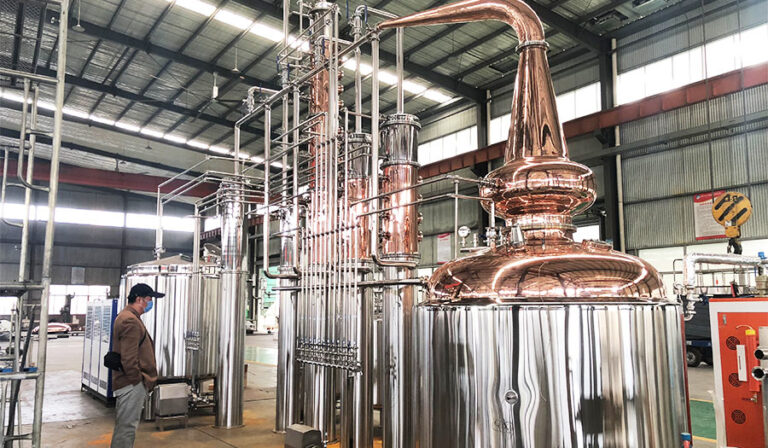Unter handwerklich hergestellten Spirituosen versteht man alkoholische Getränke mit hohem Alkoholgehalt, die durch feine Verfahren wie Destillation und Gärung hergestellt werden. Mit dem Aufkommen der handwerklichen Kultur haben immer mehr kleine Brauereien und Familienweingüter begonnen, sich mit hausgemachten Spirituosen zu befassen, und vor allem bei der Herstellung von destillierten Spirituosen ist die Wahl der Destillationsanlage entscheidend. In diesem Leitfaden wird die Ausrüstung für die Herstellung von handwerklichen Spirituosen im Detail vorgestellt, und es wird erläutert, wie man die Ausrüstung für die Herstellung von Spirituosen auswählt.
Was sind handwerklich hergestellte Spirituosen?
Als Craft-Spirituosen werden Spirituosen bezeichnet, die von Hand gebraut, in kleinem Maßstab hergestellt und von unabhängigen Brauern produziert werden. Sie unterscheiden sich von standardisierten Spirituosen, die in großem Maßstab industriell hergestellt werden. Sie legen in der Regel mehr Wert auf Personalisierung und Innovation im Produktionsprozess, bei der Auswahl der Rohstoffe und bei den Geschmackseigenschaften. Bei handwerklich hergestellten Spirituosen stehen oft die künstlerische Gestaltung und die Liebe zum Detail des Braumeisters im Vordergrund. Ihre Produkte haben einen einzigartigen Geschmack und eine hohe Qualität und sind bei den Verbrauchern, insbesondere bei Weinliebhabern, sehr beliebt.

Der Brauprozess von Craft-Spirituosen
Der Brauprozess von handwerklich hergestellten Spirituosen umfasst mehrere Schritte, darunter die Auswahl und Vorbereitung der Rohstoffe, die Gärung, Destillation, Reifung usw. Im Allgemeinen besteht der erste Schritt bei der Herstellung von Spirituosen in der Umwandlung von Zuckerquellen (wie Getreide, Früchte, Melasse usw.) in Alkohol. Der Umwandlungsprozess beruht in der Regel auf der Gärung von Hefe, und anschließend wird die hohe Alkoholkonzentration durch den Destillationsprozess extrahiert. Durch das Destillationsverfahren kann nicht nur Alkohol extrahiert, sondern auch Verunreinigungen wirksam entfernt werden, wodurch eine reinere und vielschichtigere Spirituose entsteht.
Die Destillation ist ein wichtiges Bindeglied bei handwerklich hergestellten Spirituosen und ein entscheidender Schritt bei der Bestimmung des Geschmacks und der Qualität von Spirituosen. Während des Destillationsprozesses trennen sich Alkohol und andere Bestandteile (wie Wasser, Aromastoffe usw.) aufgrund unterschiedlicher Siedepunkte. Daher ist die Wahl des richtigen Destillationsausrüstung können die stabile Qualität und den einzigartigen Geschmack jeder einzelnen Spirituosencharge gewährleisten.
Erforderliche Ausrüstung für die Destillation handwerklicher Spirituosen
Fermentationsausrüstung
Obwohl die Gärung nicht Teil des Destillationsprozesses ist, stellt sie eine wichtige Vorstufe zur Herstellung von Spirituosen dar. Die Wahl der Fermentationsanlagen wirkt sich direkt auf die Wirkung der anschließenden Destillation aus. Der Gärbehälter muss über ein ausreichendes Fassungsvermögen und eine geeignete Temperaturregelung verfügen, damit die Hefe den Zucker effizient in Alkohol umwandeln kann.
Destillationskessel (Brennblase)
Der Destillationskessel ist das wichtigste Gerät. Seine Aufgabe ist es, den Alkohol durch Erhitzen der vergorenen Flüssigkeit zu verdampfen und ihn durch das Kondensationssystem in flüssigen Alkohol umzuwandeln. Der Destillationstopf besteht im Allgemeinen aus einem Topfkörper, einem Dampfrohr, einem Kondensator usw.
- Traditioneller Destillationstopf aus Kupfer: Kupfer ist ein hervorragend wärmeleitendes Material und hat eine gute Adsorptionswirkung für Dampf, wodurch schlechte Gerüche entfernt werden können. Traditionelle Destillationskessel werden üblicherweise bei der Herstellung von Whiskey, Brandy und anderen Spirituosen verwendet.
- Destillationskessel aus rostfreiem Stahl: Moderne Destillationskessel sind in der Regel aus rostfreiem Stahl gefertigt, der eine höhere Korrosionsbeständigkeit aufweist und für die Herstellung einer Vielzahl von Spirituosen geeignet ist.
- Fraktionierter Destillationsturm: wird für feinere Fraktionierungsverfahren verwendet und eignet sich besonders für die Destillation von hochkonzentriertem Alkohol. Durch den Trenneffekt der mehrstufigen Türme kann Alkohol mit höherem Reinheitsgrad extrahiert werden.
Verflüssiger
Die Hauptfunktion des Kondensators besteht darin, den verdampften Dampf zu kühlen und in Flüssigkeit zu kondensieren. Kondensatoren bestehen in der Regel aus Kupfer- oder Edelstahlrohren, und als Kühlmethoden sind Wasserkühlung und Luftkühlung üblich. Die Konstruktion des Kondensators wirkt sich direkt auf die Effizienz der Destillation und die Reinheit des Alkohols aus.
Alkoholfraktionierer
Der Alkoholfraktionierer ist ein Gerät, das zur weiteren Trennung von Alkohol von Wasser und anderen Verunreinigungen verwendet wird. Der Fraktionator trennt verschiedene Komponenten auf der Grundlage des Unterschieds im Siedepunkt zwischen Alkohol und Wasser und anderen chemischen Komponenten. In der Regel arbeitet der Fraktionator mit dem Destillationstopf und dem Kondensator zusammen.
Weinlagertanks und Reifungsanlagen
Alkohol muss nach der Destillation in der Regel gelagert und gelagert werden, insbesondere Alkohol wie Whiskey und Branntwein, der eine gewisse Zeit benötigt, um ein reiches Aroma zu erhalten. Die Wahl der Weinlagertanks und der Reifungsausrüstung entscheidet direkt über die Qualität der Spirituosen. Weinlagertanks werden in der Regel aus Eichenholz, Stahl oder Edelstahl hergestellt, und jedes Material hat einen anderen Einfluss auf den Geschmack und die Farbe des Weins.

Wie wählt man die Destillations- und Brauereianlagen für handwerkliche Spirituosen aus?
Produktionsmaßstab
Der Produktionsumfang bestimmt die Größe und Konfiguration der Destillationsanlage. Kleine Handwerksbrauereien oder Familienbrauereien entscheiden sich in der Regel für kleine Destillationsanlagen, wie z. B. einen kleinen Destillationskessel aus Kupfer mit einem Fassungsvermögen von 20 l bis 100 l, mit dem die Flexibilität des Betriebs gewährleistet und eine verfeinerte Kontrolle erreicht werden kann. Großbrauereien müssen Geräte mit größerem Fassungsvermögen konfigurieren, z. B. Destillationskessel oder Fraktionierungstürme mit einem Fassungsvermögen von mehr als 500 Litern, die die Anforderungen der Massenproduktion erfüllen können.
Arten von Alkohol
Verschiedene Arten von Spirituosen stellen unterschiedliche Anforderungen an die Destillationsausrüstung. Für Whiskey und Branntwein beispielsweise sind in der Regel traditionelle Destillationskessel aus Kupfer erforderlich, um einzigartige Aromen zu erhalten, während Wodka effiziente Fraktionierungstürme benötigt, um hochreinen Alkohol zu gewinnen. Je nach den Eigenschaften des hergestellten Alkohols kann die Wahl der richtigen Destillationsanlage die Qualität des Endprodukts gewährleisten.
Technische Anforderungen
Hochwertige Destillationsanlagen verfügen in der Regel über eine ausgefeiltere Temperaturregelung, ein automatisches Kontrollsystem, eine Flüssigkeitsdurchflussregelung und andere Funktionen, die die Produktionseffizienz und die Reinheit des Alkohols erheblich verbessern können. Wenn es sich um eine handwerkliche Brauerei handelt, können Anlagen mit einem höheren technischen Niveau nicht nur die Produktionskapazität, sondern auch die Qualität des Weins bis zu einem gewissen Grad verbessern.
Budget und Kosten
Auch das Budget ist ein wichtiger Faktor bei der Auswahl der Destillationsanlagen. Hochwertige Kupferdestillierapparate, Fraktioniertürme und andere Ausrüstungen sind teuer, während einige kleine Destillierapparate oder vereinfachte Ausrüstungen eher für Weinkellereien mit geringerem Budget geeignet sind. Die Auswahl der verschiedenen Ausrüstungen muss entsprechend der finanziellen Situation des Weinguts vernünftig geplant werden.
Wartung der Ausrüstung für das Brauen von handwerklichen Spirituosen
- Regelmäßige Inspektion: Überprüfen Sie regelmäßig jede Komponente der Ausrüstung und reparieren oder ersetzen Sie sie rechtzeitig, wenn ein Problem festgestellt wird, um zu vermeiden, dass kleine Probleme zu einem Ausfall der Ausrüstung führen oder die Produktion beeinträchtigen.
- Reinigung und Desinfektion: Stellen Sie sicher, dass alle Geräte, die mit der Flüssigkeit in Berührung kommen, sauber gehalten werden, um zu vermeiden, dass Verunreinigungen die Flüssigkeit kontaminieren oder während der Gärung und Destillation unerwünschte Reaktionen hervorrufen.
- Wartung der Schmierung: Schmieren Sie mechanische Teile (wie Pumpen, Getriebe, Ventile usw.) regelmäßig, um die Reibung zu verringern und die Lebensdauer der Geräte zu verlängern.
- Rostschutz: Metallgeräte, insbesondere Kupfergeräte und Destillationsgefäße, werden regelmäßig einer Rostschutzbehandlung unterzogen, um Oxidation und Korrosion zu verhindern.

Lösungen für die Wartung von Destillationsanlagen
- Rost an Geräten: Kupfer- und Eisengeräte sind anfällig für Rost. Rostschutzöl oder Reinigungsöl kann regelmäßig abgewischt werden, um die Oxidation zu verhindern, insbesondere wenn die Geräte außer Betrieb sind.
- Ausfall des Temperaturkontrollsystems: Das Temperaturkontrollsystem des Gärtanks und des Destillationstopfs kann ausfallen, was zu übermäßig hohen oder niedrigen Temperaturen führt und die Gärung und Destillation beeinträchtigt. Überprüfen Sie regelmäßig den Thermostat und die Heizvorrichtung, um ihren normalen Betrieb sicherzustellen.
- Schlechte Versiegelung: Während des Destillations- und Gärungsprozesses kann eine schlechte Versiegelung zum Austritt von Alkohol und Aromabestandteilen führen und die Qualität des Weins beeinträchtigen. Überprüfen Sie alle Dichtungen und ersetzen Sie alternde oder beschädigte Dichtungen rechtzeitig.
- Verstopfung der Rohrleitung: Wenn sich Verunreinigungen oder Weinrückstände in der Rohrleitung ansammeln, kann dies zu einer Verstopfung führen. Reinigen Sie die Rohrleitung regelmäßig, um die Ansammlung von Weinrückständen zu vermeiden.
FAQ
Was sind handwerklich hergestellte Spirituosen?
Craft-Spirituosen sind Spirituosen, die von kleinen Brennereien oder unabhängigen Brauereien mit handwerklichem Geschick und innovativen Geschmacksrichtungen hergestellt werden. Im Gegensatz zu standardisierten Spirituosen aus industrieller Großproduktion stehen bei handwerklich hergestellten Spirituosen Personalisierung, Qualität und Handwerkskunst im Vordergrund, und sie haben in der Regel einzigartige Aromen und Körper. Der Schwerpunkt liegt auf der Verwendung natürlicher Zutaten und der sorgfältigen Kontrolle jedes einzelnen Brauereischritts, um einen einzigartigen und reichhaltigen Geschmack und ein einzigartiges Aroma zu erzielen.
Wie unterscheidet sich der Geschmack von handwerklich hergestellten Spirituosen von dem industrieller Spirituosen?
Der Geschmack von Craft-Spirituosen ist in der Regel komplexer und vielfältiger. Aufgrund der Verwendung natürlicher Zutaten und innovativer Verfahren weisen sie oft reiche Aromen und Geschmacksschichten auf. So kann Craft-Whiskey beispielsweise einen starken Frucht-, Rauch- oder Vanillegeschmack haben, während Craft-Gin ein frisches Kräuteraroma aufweist. Industrielle Spirituosen betonen die Reinheit des Körpers und die Einheitlichkeit des Geschmacks, und der Geschmack ist relativ stabil und einfach und zielt darauf ab, den Geschmack der Öffentlichkeit zu treffen.
Wie lagert und reift man handwerklich hergestellte Spirituosen?
- Temperaturkontrolle: Spirituosen sollten an einem kühlen, trockenen Ort und vor direkter Sonneneinstrahlung geschützt gelagert werden. Im Allgemeinen sollte die Lagertemperatur zwischen 15-20°C liegen.
- Flaschenverschluss: Achten Sie darauf, dass die Flasche gut verschlossen ist, damit sich der Alkohol nicht verflüchtigt oder oxidiert.
- Vermeiden Sie drastische Temperaturschwankungen: Vermeiden Sie die Lagerung von Spirituosen in einer Umgebung mit drastischen Temperaturschwankungen. Große Temperaturunterschiede können den Geschmack des Weins beeinträchtigen.




